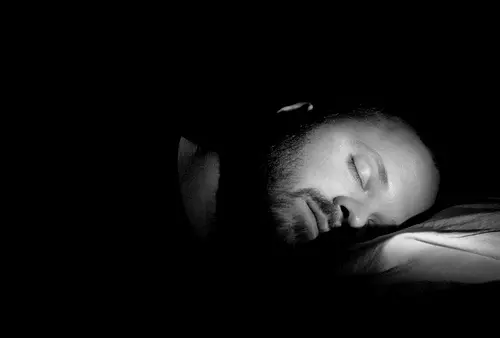Want to sleep better? When you are experiencing difficulty sleeping, it can be beyond frustrating! After all, you know the thing you need the most is sleep and yet you keep tossing and turning and worse yet thinking and rethinking! Ugh. Well, today I have a expert to share how you can get better sleep through stimulus control therapy for insomnia.

What is Stimulus Control Therapy?
This post on how stimulus control therapy can be useful for treating insomnia is contributed by Dr. Tali Shenfield, who holds a PhD in Psychology from the University of Toronto and is licensed as a Child Psychologist by the College of Psychologists of Ontario. Dr. Shenfield is accredited by the Canadian Register of Health Service Providers in Psychology and is a member of the Canadian Psychological Association. She is a Clinical Director of Richmond Hill Psychology Center specializing in psychological assessments and psychotherapy.
Stimulus Control Therapy (SCT) is a behavioral treatment technique most often used for insomnia. Stimulus Control Therapy is often part of a broader approach called Cognitive Behavioral Therapy for Insomnia (CBT-I), which aims to address the underlying causes of sleep disturbances and improve overall sleep quality. The idea is that over time, people with sleep difficulties can develop negative associations with their bed and bedroom—for example, linking them with worry instead of sleep. SCT works by retraining the brain to associate the bed only with sleep (and intimacy).
How We Become Conditioned And How It Results In Insomnia
We often don’t realize it, but we are conditioning ourselves all the time. Like Pavlov’s dogs, in the famous experiment, we have consistent reactions to specific stimulus. Pavlov’s dogs were conditioned to expect food when they heard a bell ring. After a while, the dogs would salivate whenever the bell rung, whether they got any food or not.
We do the same type of thing to ourselves all the time. Each of us often plays both Pavlov and the dog. We put ourselves in routine circumstances to which we react the same day after day, eventually, those reactions become chronic and we can’t get rid of them, even when we don’t want them anymore.
One element of our life gets associated with some other element, like the bell and food, and we can’t break the association. And so we tend to have the same emotional and physical reactions whenever we are in a particular situation. This type of conditioning is one of the more common reasons for insomnia.
How does that work?
I know this sounds odd, but it’s quite simple. Our beds become associated with things other than sleep. Have you ever laid down and tried to go to sleep? Not go to sleep, try to go to sleep. Do that often enough and your bed becomes associated not with sleeping, but trying to sleep. So, when you lay down, the first thing you do is try to go to sleep. Of course, if you’re trying, that means you’re not asleep. Worrying about not getting to sleep can also cause anticipatory anxiety, which is becoming anxious about being anxious and it gets even harder to go to sleep.
Other things our beds can become associated with are worries, fears and trying to figure out problems that we were not successful at figuring out during the day.

How To Sleep Better By Breaking Unwanted Associations Through Stimulus Control Therapy
There are certain things that we can do to break those unwanted associations and get a good night’s rest. One is to avoid watching TV in bed, unless of course it puts you to sleep, which is something that reality TV can easily do. LOL! In fact, avoid doing anything in bed that isn’t sleeping, or leading to sleeping…
You can also use something called stimulus control therapy. What is stimulus control therapy? This is a fancy term meaning creating the proper associations between the stimulus and the response. In this case, between the bed and a good rest.
Stimulus Control Therapy is a technique used in the treatment of insomnia and other sleep disorders. It aims to reassociate the bed and bedroom with sleep and to establish a consistent sleep-wake schedule.
Some key principles of Stimulus Control Therapy include:
- Use the bed only for sleep and sex: Avoid activities such as reading, watching TV, or working in bed. This helps strengthen the association between bed and sleep.
- Go to bed only when sleepy: If you’re not able to fall asleep within about 20 minutes, leave the bedroom and do a relaxing activity until you feel sleepy.
- Maintain a consistent wake-up time: This helps regulate your body’s internal clock and can improve your ability to fall asleep at night.
- Avoid naps: Napping during the day can make it harder to fall asleep at night.
- Establish a relaxing bedtime routine: Engage in calming activities before bed to signal to your body that it’s time to wind down.
- Limit exposure to bright light: Reduce exposure to bright screens (like phones or tablets) before bed, as the light can interfere with your body’s ability to prepare for sleep.
- Create a comfortable sleep environment: Keep your bedroom cool, quiet, and dark, and use a comfortable mattress and pillows.
First off, go to bed only when you are sleepy. You should also avoid doing anything in bed except sleeping, sex is the only exception, of course. If you can’t fall asleep, don’t try. Get up and go do something else. The point is to associate the bed with sleeping, not television, not the day’s problems and most certainly not with trying to sleep. The part of our minds that makes associations is very literal. So remember that if you are laying in bed trying to go to sleep, then you are programming your mind to try and go to sleep, not sleep. Take off the pressure and relax, anxiety is the most common cause of insomnia.
Working out in the evening may be just want you need to blow off steam and help you relax at night. Or maybe a warm bath is more your speed. Maybe both! Do what works to make you tired before you lay down in bed.
Conclusion
As the American Pyschological Association says, “the goal of Stimulus Control is to reteach your body and your brain that when you get into bed you should fall asleep.” Try to make your schedule as regular as possible so your body knows when to expect to fall asleep. Go to sleep when you are tired; do exercise to make you tired if you needed. After you have gone to bed, if you are not asleep in 20 minutes, you should get out of bed and do something relaxing- not watching TV. (Getting sucked into binge watching a series will not help!) I suggest reading a book, yoga, meditation, whatever relaxes you. I hope that using stimulus control therapy helps you avoid insomnia. Let me know how it goes or if you have questions @familyfocusblog.
Related Posts:
Red Light Therapy Benefits & Devices

Robin (Masshole Mommy) says
Interesting post. I am sleepy when I go to bed, but I also end up laying there “thinking” before I fall asleep…..and thinking means worrying most of the time.
Jeff says
What works best for me is meditation before I go to bed. I know that most “meditation gurus” will tell you that it’s wrong timing, but it helps 🙂
This is my personal “stimulus control therapy”…
Anna says
Interesting read about stimulus control therapy. I tried using Zeo sleep monitor but it didn’t help at all, in fact I couldn’t fall asleep with band on my forehead.
Michael says
Stimulus Control is the most supported component of cognitive behavioral therapy for insomnia. It just takes a while to work. Intensive Sleep Retraining (ISR) was shown to work much more quickly. SleepQ is an iPhone app to let people do ISR at home.
Michael
Barry Smith says
Insomnia sucks. I do like what you’re saying. The issue for me, often times my brain is just overloaded and spins out of control. I’ve used the NounedToSleep app for the last month & it’s quieted my brain every time and I’m sleeping before I know. Whacky concept, but it seems to work.